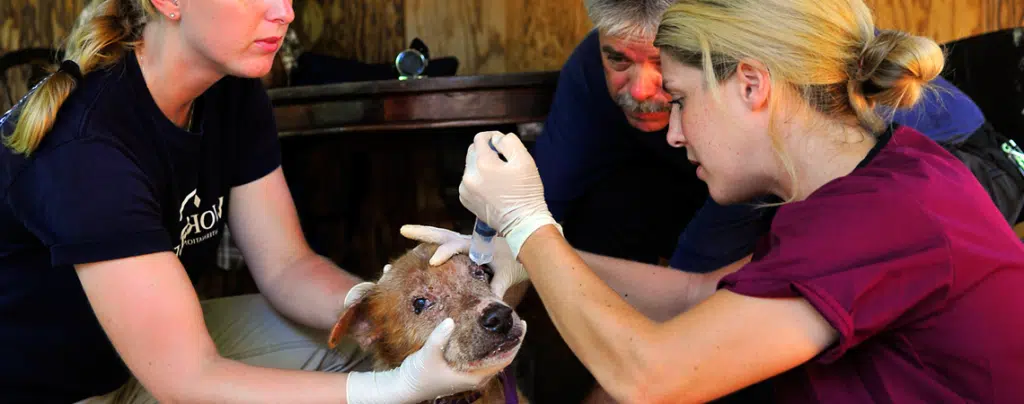Pet abuse and domestic violence are closely linked. Animals can’t talk but University of Sydney vet Dr Lydia Tong has shown vets how to tell the difference between bone fractures caused by accidents and those caused by abuse. Her fracture identification methods are giving vets the added confidence to identify cases of violence against pets and could serve as a warning of domestic violence.
Now, in a new study with Domestic Violence NSW, Lydia is looking deeper into the connections between animal abuse and domestic violence to assess the need for better services to protect both human and animal victims.
“Around 70% of women escaping violent homes also report pet abuse,” says Lydia. “So vets are often the first to see evidence of abuse in a family, when they treat injured pets.”
“Different forces on bones can tell a story—the skeleton of an animal keeps a distinct record that indicates the force applied to bones from past injuries, breaks or fractures. But it can often be difficult for vets to say with confidence whether a fracture has resulted from abuse or accident.”
To give vets this confidence, in a 2014 study, Lydia collected cases of abused dogs who were punched, hit with a blunt weapon or kicked, and examined the fractures from these injuries. She then compared these fractures to those caused by genuine accidents. Her results, published in The Veterinary Journal, identified five key features of fractures that vets could look for to distinguish accidents from abuse.
Now, having given vets this reference to diagnose abuse, Lydia and her colleagues at The University of Sydney are gathering more information on the connections between domestic violence and animal abuse.
“We already know that many women will delay seeking shelter if their pets are threatened or can’t be housed along with them,” explains Lydia.
“US studies also tell us that domestic violence perpetrators who also abuse pets are more dangerous—they have increased rates of physical and sexual violence and stalking, and are more likely to kill their partner.
“We need to know more about the relationship between animal and human abuse in Australia so that we can recognise abuse earlier, save lives, and provide appropriate services for victims and their pets.”
Lydia and her colleagues at the University of Sydney are working with Domestic Violence NSW to survey victims of domestic violence who are also pet owners.
“Perpetrators of violence will often threaten to abuse or harm family pets as a way to exert control” says Moo Baulch, CEO of Domestic Violence NSW.
“This research is essential because we need to have a much clearer picture of the connections between domestic and family violence and the abuse of animals.
“Building a solid evidence base in this area will assist policymakers, domestic and family violence services and people working with animals to better respond to the needs of women and children with pets who are experiencing violence and are afraid to leave.”
Lydia and her team are keen to hear from other domestic violence support agencies, services or refuges that would be willing to be involved with this study.
Lydia was a 2014 national finalist of FameLab Australia. FameLab is a global science communication competition for early-career scientists.
Media call: Lydia Tong and Moo Baulch will be available for interview at The University of Sydney Veterinary Teaching Hospital, Evelyn Williams Building B10, The University of Sydney NSW, from 11am-12noon, Sunday 17 August 2014. See online map
Contacts:
Dr Lydia Tong, The University of Sydney, +61 425 166 516, lydia.tong@sydney.edu.au
Verity Leatherdale, The University of Sydney Media, +61 403 067 342, verity.leatherdale@sydney.edu.au
Niall Byrne, Science in Public, +61 417 131 977, niall@scienceinpublic.com.au
Errol Hunt, Science in Public, +61 423 139 210, errol@scienceinpublic.com.au
Background
In Australia, an estimated 300,000 pets are exposed to abuse in their own homes every year. In 2012, the RSPCA investigated over 51,000 cruelty complaints, but only 298 convictions resulted. In part, this is because the scientific tools to confidently diagnose animal abuse are underdeveloped.
Lydia’s work on identifying animal abuse fractures is aimed at addressing this gap by examining canine abuse injuries in order to determine what differentiates them from accidents.
Her work has been published in: L.J. Tong, Fracture characteristics to distinguish between accidental injury and non-accidental injury in dogs, The Veterinary Journal, 199 (2014) 392–398.
Abstract
Non-accidental injury (NAI) refers to trauma arising from deliberate physical abuse and is increasingly recognised as an important differential diagnosis in veterinary medicine. Given the sensitivity and importance of identifying NAI, clinicians, pathologists, and veterinary forensic experts need clear scientific evidence to support their diagnosis. The aim of this study was to investigate fractures occurring in accidental and NAI in dogs by comparing the radiographic features of fractures in 19 dogs with abuse fractures and 135 dogs with accidental fractures.
Radiographic findings indicated that the following five features should raise the index of suspicion of and support a diagnosis of NAI: (1) the presence of multiple fractures; (2) fractures occurring on more than one region of the body (forelimb, hind limb, or axial); (3) transverse fractures; (4) fractures presenting at a later stage of healing (delayed presentation); and (5) multiple fractures at different stages of healing. Staffordshire bull terriers were over-represented in the NAI group. Many findings in this study correlate with patterns seen in human NAI fractures. However some aspects show significant differences, serving as a reminder that veterinary forensics cannot rely on data from existing human studies. http://dx.doi.org/10.1016/j.tvjl.2013.08.019
Contact errol@scienceinpublic.com.au for a copy of the paper.
Acknowledgements
Lydia is collaborating with Associate Professor Peter Thomson, Faculty of Veterinary Science, The University of Sydney, to deliver the upcoming survey.
Welfare services
For advice or help regarding temporary housing for pets for owners escaping domestic or family violence, contact the RSPCA’s Safe Beds for Pets program on safebeds@rspcansw.org.au or phone (02) 9782 4408.
For help or advice regarding any domestic violence matter, contact Domestic Violence NSW on 1800 65 64 63 or go to domesticviolence.nsw.gov.au
FameLab
In 2014, the British Council and Fresh Science have joined forces to bring FameLab to Australia.
FameLab Australia will offer specialist science media training and, ultimately, the chance for early-career researchers to pitch their research at the FameLab International Grand Final in the UK at The Times Cheltenham Science Festival from 3 to 5 June 2014.
FameLab is an international communication competition for scientists, including engineers and mathematicians. Designed to inspire and motivate young researchers to actively engage with the public and with potential stakeholders, FameLab is all about finding the best new voices of science and engineering across the world.
Founded in 2005 by The Times Cheltenham Science Festival, FameLab, working in partnership with the British Council, has already seen more than 5,000 young scientists and engineers participate in over 23 different countries — from Hong Kong to South Africa, USA to Egypt.
Now, FameLab comes to Australia in a landmark collaboration with the British Council and Fresh Science — Australia’s very own science communication competition.
For more information about FameLab Australia, head to www.famelab.org.au







 Fresh Science is on hold for 2022. We will be back in 2023.
Fresh Science is on hold for 2022. We will be back in 2023.